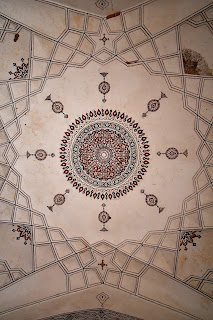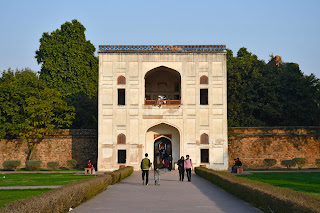Central Delhi
Today was another sunny and busy day, with my explorations broken up by three meetings early in the afternoon. I started the morning by catching an autorickshaw to Shri Laxmi Narayan Temple. It was built on the initiative of Mohandas Gandhi with the goal of serving all castes – a very progressive idea for the time. Although quite glamorous and expansive on the outside, the interior of the temple is not overly ornate, with little to attract the eye beside the statue of each shrine’s main deity.
Within
walking distance of the Shri Laxmi Narayan Temple lies the Gurdwara Sri Bangla
Sahib, a Sikh place of worship. I flailed about for a while trying to discover the
exact procedure for visiting, though it was really quite simple. All I had to
do was deposit my shoes at the counter, put a little cloth on my head, and walk
to the stairs through a shallow pool of water. Purchasing and making an
offering, I concluded, was not compulsory. A ceremony was underway in the
temple, with the incantations written on electronic boards and translated into
English.
Once again,
I walked to my next destination: the old astronomical observatory. Just like
the one in Jaipur, New Delhi’s Jantar Mantar was constructed by Maharaja Jai
Singh II. It is perhaps somewhat smaller than its better-known cousin and does
not have as many instruments, but it reinforces its uniqueness with its bright
red colour, as opposed to the pastel shades of Jaipur’s. Finally, I stopped by
Agrasen Ki Baoli, a massive step well that now serves as a place for young
people to hang out and chat.
By the time
my meetings ended, the weather had turned markedly inhospitable. The wind
picked up and for a moment, it even started to rain. I was near India Gate when
the first drops began to fall, but my intuition told me it would not last.
After letting a few autorickshaw drivers fight over me, I found myself fighting
the winner, who tried to convince me to visit a bazaar instead. Saying the
roads would be full because of the bad weather, he took every instance of
traffic as proof of his assessment. As both my optimism and will were
inflexible, though, he could do little but alternately complain and gloat while
driving me to Sunder Nursery.
By the time
we reached Sunder Nursery, I had been proven right. It stopped raining and
after some time, the sky became blue again. I walked around Sunder Nusery,
admiring the beautiful ceilings of the different tombs and enjoying the park’s
greenery. I’d also just checked my emails and discovered that I had received a
job offer, which lifted a heavy weight off my chest.
Just across
the road from Sunder Nursery is the entrance to Humayun’s Tomb. Really, the
name of this complex is shorthand for a collection of impressive tombs, of
which Humayun’s is simply the most monumental. Seen as a precursor to the Taj
Mahal, it too is a highly symmetrical structure with its domed building
standing atop a vaulted pedestal. Unlike the Taj Mahal, however, Humayun’s Tomb
is made of red and beige sandstone. The other major tomb in this complex is
that of Isa Khan, which is octagonal in shape and more colourful than many of
the rest.
There is
something intriguing about the figure of Humayun, who had to flee Delhi to
Persia and only reconquered the city with the help of the Safavids fifteen
years later. Son of the Mughal patriarch Baber and descendant of both Timur and
Genghis Khan, Humayun would go on to father the great emperor Akbar, who
himself was the grandfather of the famous Shah Jahan. Upon his return from
Persia, Humayun was accompanied by a number of artisans and nobles who brought
their culture and exerted significant influence over the prevalent styles in
Delhi.
















































Comments
Post a Comment